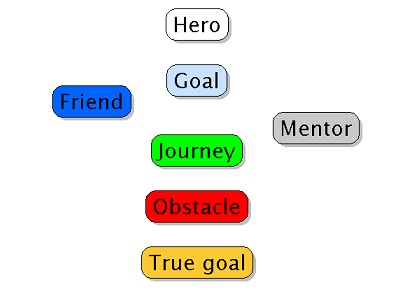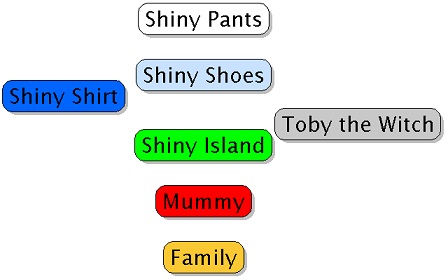Yesterday I saw a presentation by enthusiastic improvisational theatre troupe that calls itself “Story Pirates”. They work with little kids, helping those kids to build confidence in their creativity. The particular way that they work is to convert stories from kids into theatre pieces, which they then act out, with verve, humor and fun.
In yesterday’s presentation, they worked with the kids to a really fun little seven minute epic, which ended up as something like this:
“Shiny Pants was sad because he was incomplete — ne needed shiny shoes. One day he meets a friend, Shiny Shirt. They decide to go together to find Shiny Shoes. The run into Toby the Witch, who tells them that to find the shiny shoes, they will need to journey to Shiny Island. On the way they run into the dreaded Toilet Paper Mummy, but they overcome this obstacle, make it to the island and find the Shiny Shoes. In the end they realize that they are happy, not because they found the Shiny Shoes, but because they found each other — they are now a family.”
Although when I saw a demonstration of the troupe in action, what I saw was more like a kind of Mad Libs game — the actors would ask the kids such questions as “what’s the name of the hero,” and then make a story around that. Although the kids thought they were creating a story, everything but the specific names actually came from the improv troupe.
As I thought about what this underlying story was, I realized it was the classic Hero’s Journey, as described by Joseph Campbell in The Hero with a Thousand Faces. Here is my diagramming of this underlying story:

What the kids provided was just a naming of the pieces of this diagram:

Hopefully, in their extended workshops the Story Pirates bring kids in on this underlying process. Because that’s what it will take to really help kids learn how to be great storytellers.
Mad Libs is a good analogy for the overall shape of the plot. The text of the story (jokes, details, etc.) is actually more dynamic than Mad Libs, since it is made up on the spot in response to the specific items supplied by the kids. For example, there was a running physical “joke” with the characters sort of squinting when they looked at each other because they were so shiny. Those details made the story fun and unique, and indeed, they were supplied by the actors, not the kids. I don’t know how they run their workshops, but it would be educational to go back to the kids to discuss both the classic shape of the plot as well as how the details did or didn’t work to add richness.
Ken, I used this doodle during a high school workshop on Story Games, using Rory’s Story Cubes as randomizers for this particular activity.
Here’s a brief writeup on Google+:
https://plus.google.com/107569697374640025648/posts/Y7w3qFDwv2e
Thanks!